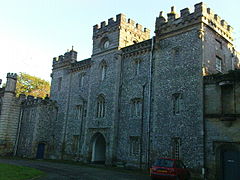Castle Goring
| Castle Goring | |
|---|---|

Castle Goring's Gothic north side
|
|
| General information | |
| Architectural style | Greco-Palladian and Gothic |
| Town or city | Worthing, West Sussex |
| Country | England |
| Completed | 1797-1798 |
| Cost | £90,000 |
| Client | Sir Bysshe Shelley |
| Design and construction | |
| Architect | John Rebecca |
Castle Goring is a Grade I listed country house in Worthing, in Sussex, England. One of Worthing's two Grade I listed buildings (deemed by the Department for Culture, Media & Sport to be of exceptional interest), it has been described by architectural critic Ian Nairn as reflecting "the equivocal taste of the 1790s as well as anywhere in the country."
Castle Goring was designed by John Rebecca for Sir Bysshe Shelley, 1st Baronet. It was intended that his grandson, Percy Bysshe Shelley, would live at Castle Goring; however, the poet drowned in Italy aged just 29, so he never took possession.
In 1845, Mary Shelley, who inherited the building as widow of the poet, sold it to Brooke-Pechel. It is currently owned by Lady Colin Campbell, first wife of Lord Colin Ivar Campbell, younger son of the Eleventh Duke of Argyll.
When it was built in the 1790s, Castle Goring was in the far north of the parish. Since Goring-by-Sea became part of the borough of Worthing in 1929, development has extended to the borders of the Castle Goring estate, and the estate now borders on the West Durrington area of the town, several kilometres from the centre of Goring.
Castle Goring lies adjacent to the A27 road from Worthing to Chichester, at grid reference TQ 102056, to the northwest of Worthing. It also lies within the South Downs National Park next to ancient woodland at Titnore Wood.
The building has a front and rear of different styles. The north side of Castle Goring is Gothic and is thought to resemble Arundel Castle 8 km (5.0 mi) to the west, while the south side has a Greco-Palladian front of yellow brick, said to be a copy of the Villa Lante near Rome.
...
Wikipedia
